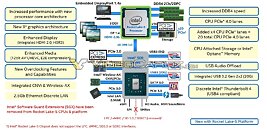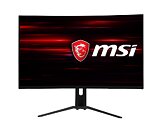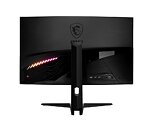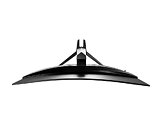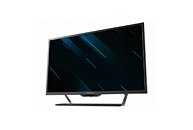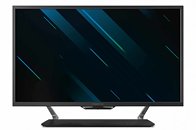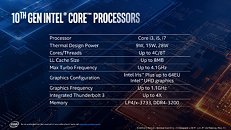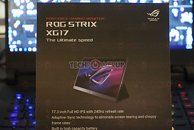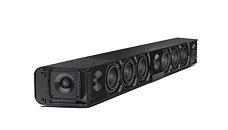Mar 29th, 2025 07:39 EDT
change timezone
Latest GPU Drivers
New Forum Posts
- Future-proofing my OLED (56)
- Did Nvidia purposely gimp the performance of 50xx series cards with drivers (114)
- Upgrade from a AMD AM3+ to AM4 or AM5 chipset MB running W10? (14)
- What are you playing? (23305)
- AMD RX 9070 XT & RX 9070 non-XT thread (OC, undervolt, benchmarks, ...) (71)
- TPU's F@H Team (20414)
- Have you got pie today? (16650)
- Which thermal paste never pumps out? (67)
- Is RX 9070 VRAM temperature regular value or hotspot? (264)
- WCG Daily Numbers (12815)
Popular Reviews
- Sapphire Radeon RX 9070 XT Pulse Review
- Samsung 9100 Pro 2 TB Review - The Best Gen 5 SSD
- ASRock Phantom Gaming B850 Riptide Wi-Fi Review - Amazing Price/Performance
- Assassin's Creed Shadows Performance Benchmark Review - 30 GPUs Compared
- be quiet! Pure Rock Pro 3 Black Review
- Sapphire Radeon RX 9070 XT Nitro+ Review - Beating NVIDIA
- ASRock Radeon RX 9070 XT Taichi OC Review - Excellent Cooling
- Palit GeForce RTX 5070 GamingPro OC Review
- Pulsar Feinmann F01 Review
- AMD Ryzen 7 9800X3D Review - The Best Gaming Processor
Controversial News Posts
- AMD RDNA 4 and Radeon RX 9070 Series Unveiled: $549 & $599 (260)
- MSI Doesn't Plan Radeon RX 9000 Series GPUs, Skips AMD RDNA 4 Generation Entirely (142)
- Microsoft Introduces Copilot for Gaming (123)
- AMD Radeon RX 9070 XT Reportedly Outperforms RTX 5080 Through Undervolting (118)
- NVIDIA Reportedly Prepares GeForce RTX 5060 and RTX 5060 Ti Unveil Tomorrow (115)
- Over 200,000 Sold Radeon RX 9070 and RX 9070 XT GPUs? AMD Says No Number was Given (100)
- NVIDIA GeForce RTX 5050, RTX 5060, and RTX 5060 Ti Specifications Leak (96)
- Retailers Anticipate Increased Radeon RX 9070 Series Prices, After Initial Shipments of "MSRP" Models (90)
News Posts matching #HDMI
Return to Keyword Browsing
BenQ Launches SW321C 32-inch Monitor
BenQ today announced the latest addition to its monitor family design for professional use. The SW321C, as it is called, is a 32-inch monitor with an IPS panel of 4K (3840×2160p) resolution. The panel itself is a 60 Hz screen with 250 nits of brightness, 1000:1 contrast ratio, 5 ms GtG response time, and it offers 178-degree viewing angles, which is standard for IPS panels. When it comes to the color coverage and the ability to accurately represent them, the SW321C features 95% of the DCI-P3, 99% of the Adobe RGB, and 100% of the sRGB color gamut. It has a 16-bit 3D look-up table (LUT) and features calibration for DeltaE ≤ 2.
The monitor comes with HDR10 specification, however, due to the brightness of 250 nits, it is not capable of performing any serious HDR content editing. Another interesting note is that this monitor supports Hybrid Log-Gamma (HLG) standard, which is an uncommon one. For input, the monitor had support for one DisplayPort 1.4, two HDMI 2.0, and one USB-C port. There is a dual-port USB hub, which has an SD card reader right next to it, making this very useful feature for photographers. Exact pricing and availability of this monitor are unknown, however, it is supposed to hit the market soon.
The monitor comes with HDR10 specification, however, due to the brightness of 250 nits, it is not capable of performing any serious HDR content editing. Another interesting note is that this monitor supports Hybrid Log-Gamma (HLG) standard, which is an uncommon one. For input, the monitor had support for one DisplayPort 1.4, two HDMI 2.0, and one USB-C port. There is a dual-port USB hub, which has an SD card reader right next to it, making this very useful feature for photographers. Exact pricing and availability of this monitor are unknown, however, it is supposed to hit the market soon.

Intel Rocket Lake-S Platform Detailed, Features PCIe 4.0 and Xe Graphics
Intel's upcoming Rocket Lake-S desktop platform is expected to arrive sometime later this year, however, we didn't have any concrete details on what will it bring. Thanks to the exclusive information obtained by VideoCardz'es sources at Intel, there are some more details regarding the RKL-S platform. To start, the RKL-S platform is based on a 500-series chipset. This is an iteration of the upcoming 400-series chipset, and it features many platform improvements. The 500-series chipset based motherboards will supposedly have an LGA 1200 socket, which is an improvement in pin count compared to LGA 1151 socket found on 300 series chipset.
The main improvement is the CPU core itself, which is supposedly a 14 nm adaptation of Tiger Lake-U based on Willow Cove core. This design is representing a backport of IP to an older manufacturing node, which results in bigger die space due to larger node used. When it comes to the platform improvements, it will support the long-awaited PCIe 4.0 connection already present on competing platforms from AMD. It will enable much faster SSD speeds as there are already PCIe 4.0 NVMe devices that run at 7 GB/s speeds. With RKL-S, there will be 20 PCIe 4.0 lanes present, where four would go to the NVMe SSD and 16 would go to the PCIe slots from GPUs. Another interesting feature of the RKL-S is the addition of Xe graphics found on the CPU die, meant as iGPU. Supposedly based on Gen12 graphics, it will bring support for HDMI 2.0b and DisplayPort 1.4a connectors.
The main improvement is the CPU core itself, which is supposedly a 14 nm adaptation of Tiger Lake-U based on Willow Cove core. This design is representing a backport of IP to an older manufacturing node, which results in bigger die space due to larger node used. When it comes to the platform improvements, it will support the long-awaited PCIe 4.0 connection already present on competing platforms from AMD. It will enable much faster SSD speeds as there are already PCIe 4.0 NVMe devices that run at 7 GB/s speeds. With RKL-S, there will be 20 PCIe 4.0 lanes present, where four would go to the NVMe SSD and 16 would go to the PCIe slots from GPUs. Another interesting feature of the RKL-S is the addition of Xe graphics found on the CPU die, meant as iGPU. Supposedly based on Gen12 graphics, it will bring support for HDMI 2.0b and DisplayPort 1.4a connectors.

Acer Launches two Predator Monitors with 240 Hz Refresh Rate
Acer Japan has today launched two predator monitors based on IPS technology. The two monitors in question are 24.5-inch and 27-inch IPS panels based on 1080p resolution named XB253QGXbmiiprzx (the 24.5-inch model) and XB273GXbmiiprzx (27-inch model), which is not a typo and are the actual name of the models. Both of them feature Display HDR400 certifications, meaning that their maximum brightness is 400 nits. Other specifications include a maximum supported refresh rate of 240 Hz with 1 ms GtG response time that can be reduced to 0.5 ms response time with override mode. There are two options of frame syncing, where one is NVIDIA's G-SYNC, and the other is VESA's Adaptive-Sync. Both of them support up to 240 Hz refresh rate, meaning that you can use any card to get syncing at a high refresh rate. The IPS screen covers 99% of the sRGB color gamut.
For connectivity, Acer has equipped these monitors with one DisplayPort 1.2a, and two HDMI 2.0b ports used for input. There is a USB hub with four USB 3.0 ports and one 3.5 mm headphone jack output. The monitor is rocking two 2 W integrated stereo speakers. When it comes to the pricing, the smaller 24.5-inch model is priced at around ¥46,000 ($430 in the United States) and ¥55,000 (around $500 in the US).
For connectivity, Acer has equipped these monitors with one DisplayPort 1.2a, and two HDMI 2.0b ports used for input. There is a USB hub with four USB 3.0 ports and one 3.5 mm headphone jack output. The monitor is rocking two 2 W integrated stereo speakers. When it comes to the pricing, the smaller 24.5-inch model is priced at around ¥46,000 ($430 in the United States) and ¥55,000 (around $500 in the US).

Samsung Launches T55 Series of Office Monitors with 1000R Curvature
Samsung today introduced the latest T55 series of monitors designed for an office use case. To kick-off the new lineup, Samsung launched three monitors that have similar specifications, but their respective size is the only differentiator. The new models are C24T55, C27T55, and C32T55 which feature 24-inch, 27-inch, and 32-inch display panels respectively. All of them feature 1000R curvature applied to ease the eye strain, making them a very unique choice for an office monitor.
Besides the different screen sizes, all of the monitors feature similar specifications such as a 1080p VA screen clocked at a 75 Hz refresh rate. Besides having support for AMD's FreeSync technology, these monitors have 4 ms GtG response time, so they are not exactly gaming oriented. The displays cover 1.193 of the sRGB color spectrum and 0.884 of Adobe RGB, so despite being a VA panel, it is not bad. The brightness level is a standard 250 nit specification for an office monitor, and the contrast ration is 3000:1. To feed the monitor with image, you can choose anything from HDMI 1.4, DisplayPort 1.2, or D-Sub connector. While the 24-inch version doesn't include any in-built speaker, the 27-inch and 32-inch versions have a pair of 5 W stereo speakers. There are no VESA mounting points, so to stand the monitor relies on its own stand which can tilt from -3° to 20°.
Besides the different screen sizes, all of the monitors feature similar specifications such as a 1080p VA screen clocked at a 75 Hz refresh rate. Besides having support for AMD's FreeSync technology, these monitors have 4 ms GtG response time, so they are not exactly gaming oriented. The displays cover 1.193 of the sRGB color spectrum and 0.884 of Adobe RGB, so despite being a VA panel, it is not bad. The brightness level is a standard 250 nit specification for an office monitor, and the contrast ration is 3000:1. To feed the monitor with image, you can choose anything from HDMI 1.4, DisplayPort 1.2, or D-Sub connector. While the 24-inch version doesn't include any in-built speaker, the 27-inch and 32-inch versions have a pair of 5 W stereo speakers. There are no VESA mounting points, so to stand the monitor relies on its own stand which can tilt from -3° to 20°.

AOC Releases the AGON AG353UCG Monitor: 35" VA, 3440 x 1440 UWQHD, Quantum Dot, 200 Hz, DisplayHDR 1000, G-Sync Ultimate, 1800R
AOC launches the 35" (88.98 cm) AGON AG353UCG with 200 Hz refresh rate, 2 ms GtG response time, 3440 x 1440 UWQHD (21:9) resolution, VESA DisplayHDR 1000 and Nvidia G-Sync Ultimate.
Its native 3440 x 1440 UWQHD (21:9) resolution combined with the 1800R curvature creates the next level of immersion. The AG353UCG's visuals pop thanks to Quantum Dot technology, 1000 nits peak brightness with VESA DisplayHDR 1000, 2500:1 contrast and 90% DCI-P3 coverage. Finally, the monitor supports Nvidia G-Sync Ultimate, offering HDR with 1000 nits brightness, at the same time eliminating stutter, tearing and reducing latency.
Its native 3440 x 1440 UWQHD (21:9) resolution combined with the 1800R curvature creates the next level of immersion. The AG353UCG's visuals pop thanks to Quantum Dot technology, 1000 nits peak brightness with VESA DisplayHDR 1000, 2500:1 contrast and 90% DCI-P3 coverage. Finally, the monitor supports Nvidia G-Sync Ultimate, offering HDR with 1000 nits brightness, at the same time eliminating stutter, tearing and reducing latency.

MSI Unveils Optix MAGG322CR Monitor with 180 Hz Refresh Rate
Today MSI announced the latest addition to its monitor lineup - the MSI Optix MAGG332CR gaming monitor. With its 180 Hz refresh rate, this monitor is targeting gamers who focus on first-person shooter games primarily. When it comes to the panel characteristics, this monitor is rocking a 31.5-inch anti-glare 1080p display with a 1500R curvature applied to it. The panel type in question is an 8-bit VA panel with Frame Rate Control (FRC) that enables the monitor to achieve a wider color spectrum withing the 8-bit range.
The monitor offers 1 ms Moving Picture Response Time (MPRT) performance, along with the brightness of 300 nits, and a contrast ratio of 3000:1. When it comes to the refresh rate syncing technology, there is VESA's Adaptive-Sync present with AMD FreeSync certification. Marked as "HDR Ready", it is not exactly meeting any requirements due to its 300 nits brightness, however, there is at least a possibility to view HDR content. The display covers 96% of DCI-P3 and 125% of sRGB color gamut. Additionally, for input, there are quite a few options. There is one DisplayPort 1.2a, two HDMI 2.0b connectors, and one USB-C port that supports DisplayPort alternate mode allowing for video input over USB. There is also a USB hub present with two USB 2.0 ports and for audio, there is one 3.5 mm headphone output port. Besides, support for MSI Mystic Light RGB setup is also present.
The monitor offers 1 ms Moving Picture Response Time (MPRT) performance, along with the brightness of 300 nits, and a contrast ratio of 3000:1. When it comes to the refresh rate syncing technology, there is VESA's Adaptive-Sync present with AMD FreeSync certification. Marked as "HDR Ready", it is not exactly meeting any requirements due to its 300 nits brightness, however, there is at least a possibility to view HDR content. The display covers 96% of DCI-P3 and 125% of sRGB color gamut. Additionally, for input, there are quite a few options. There is one DisplayPort 1.2a, two HDMI 2.0b connectors, and one USB-C port that supports DisplayPort alternate mode allowing for video input over USB. There is also a USB hub present with two USB 2.0 ports and for audio, there is one 3.5 mm headphone output port. Besides, support for MSI Mystic Light RGB setup is also present.

Matrox Introduces D-Series Graphics Cards for High-Density-Output Video Walls
Matrox is pleased to announce Matrox D-Series, a new family of next-generation, multi-display graphics cards designed to power video walls in commercial and critical 24/7 environments. These new single-slot graphics cards drive up to four 4Kp60 displays and can be easily combined to output up to 16 x 4K monitors for high-density video walls in control rooms, enterprises, industries, government, military, pro A/V, digital signage, security, and more. Matrox D-Series graphics cards will be in action at ISE 2020 (booth 11-D120).
Leveraging a custom-built NVIDIA Quadro embedded GPU, D-Series delivers smooth video playback and graphics performance on up to four high-resolution HDMI or DisplayPort displays. OEMs, system integrators, and AV installers can also combine up to four D-Series cards via board-to-board framelock cables, to drive up to sixteen synchronized 4K displays. In addition, D-Series offers HDCP support for playback of protected audio and video content, as well as Microsoft DirectX 12, OpenGL 4.5, and OpenCL 1.2 support to run the latest professional applications.
Leveraging a custom-built NVIDIA Quadro embedded GPU, D-Series delivers smooth video playback and graphics performance on up to four high-resolution HDMI or DisplayPort displays. OEMs, system integrators, and AV installers can also combine up to four D-Series cards via board-to-board framelock cables, to drive up to sixteen synchronized 4K displays. In addition, D-Series offers HDCP support for playback of protected audio and video content, as well as Microsoft DirectX 12, OpenGL 4.5, and OpenCL 1.2 support to run the latest professional applications.

QNAP Releases Intel Dual-Core Powered TS-251D Multimedia NAS
QNAP Systems, Inc. today launched the 2-bay TS-251D NAS. Powered by an Intel J4005 dual-core processor, the TS-251D can be used with QNAP's smart AI photo management application, QuMagie, which integrates AI image recognition to group similar photos together in album "People", "Things" and "Places". The 4K media transcoding and streaming capabilities of the TS-251D brings users an excellent and satisfying cross-device multimedia experience. The TS-251D also provides a PCIe slot for expanding its core functionality.
Powered by an Intel Celeron J4005 dual-core 2.00 GHz processor (burst up to 2.7 GHz), DDR4 RAM (up to 8 GB), one Gigabit LAN port, and supports SATA 6 Gbps drives. The TS-251D provides dependable read/write speeds and Intel AES-NI 256 hardware-accelerated encryption to secure sensitive and confidential data on the NAS. The TS-251D also supports snapshots, allowing users to quickly recover data in the event of accidental deletion/modification or ransomware attack.
Powered by an Intel Celeron J4005 dual-core 2.00 GHz processor (burst up to 2.7 GHz), DDR4 RAM (up to 8 GB), one Gigabit LAN port, and supports SATA 6 Gbps drives. The TS-251D provides dependable read/write speeds and Intel AES-NI 256 hardware-accelerated encryption to secure sensitive and confidential data on the NAS. The TS-251D also supports snapshots, allowing users to quickly recover data in the event of accidental deletion/modification or ransomware attack.
Sharp's Dynabook Portégé is World's Lightest 13-inch Notebook
At this year's CES show, Sharp, a company behind Dynabook, unveiled what they call the world's lightest 13-inch notebook weighing in at just 1.9 lbs or 0.86 kilograms for all the metric system folks out there. The Portégé X30L-G as it is called is a 13-inch laptop of many qualities. For starters, it comes equipped with a 13.3-inch, 1080p IGZO display with a peak brightness of 470 nits. At its core, the Portégé X30L-G uses Intel's 10th generation of Core processors, presumably the Comet Lake variants. Onboard is also Intel's WiFi 6 standard for faster internet speeds, while the I/O is petty decent as well with two USB-A, one USB-C, one HDMI and one Ethernet port.
The laptop's chassis is made out of magnesium alloy and it features dust and drops resistance per military testing methodologies, making it a durable design that can take on everyday work. Additionally, there is a battery of unknown capacity that is advertised to last up to 14.5 hours, however, that is based on Dynabook's testing and we will have to wait for 3rd party reviews to confirm. The X30L-G is going to arrive sometime in February for the price of $1600.
The laptop's chassis is made out of magnesium alloy and it features dust and drops resistance per military testing methodologies, making it a durable design that can take on everyday work. Additionally, there is a battery of unknown capacity that is advertised to last up to 14.5 hours, however, that is based on Dynabook's testing and we will have to wait for 3rd party reviews to confirm. The X30L-G is going to arrive sometime in February for the price of $1600.

PowerColor at CES 2020: RX 5700 XT Liquid Devil, 5600 XT Red Devil and Red Dragon
PowerColor at CES 2020 took the opportunity provided by AMD's announcement of the RX 5600 XT graphics cards to showcase their offerings on that SKU. Based on a graphics card that AMD announced would be targeting the $279 price point, PowerColor will be launching two SKUs based on the Navi silicon: RX 5600 XT Red Devil and Red Dragon.
The RX 5700 XT Liquid Devil is based on PowerColor's RX 5700 XT started shipping back in November 25th.
The RX 5700 XT Liquid Devil is based on PowerColor's RX 5700 XT started shipping back in November 25th.

Acer Unveils Predator CG437KP monitor: 43" VA, 4K, 144 Hz, Adaptive Sync, 1000 nits
(UPDATE: Acer has now launched the monitor) Acer at a special event unveiled their upcoming monitor that blurs the line between a television and a PC monitor. The Predator CG437KP makes use of a 43" VA panel (90% DCI-P3 coverage and low Delta E<1 color accuracy) with a 4K resolution. As if the size wasn't an impressive spec alone, Acer really have gone out of their way to make this a veritable Predator monitor, with 144 Hz refresh rates. The monitor also comes with Adaptive Sync support for both AMD FreeSync and NVIDIA G-Sync and over HDMI for compatibility with current and future consoles. There's a maximum 1000 nits brightness, which brings VESA's DisplayHDR 1000 certification to the table.
I/O stands at 3x HDMI (likely to support all of those consoles users that are looking at this diagonal size might have), 2x DisplayPort 1.4 for actual Active Sync users, 1x USB 3.1-C, 2xUSB 3.0 and 2xUSB 2.0. There's even a remote control. The Acer Predator CG437KP is now available in the US at $1,499.99 MSRP.
I/O stands at 3x HDMI (likely to support all of those consoles users that are looking at this diagonal size might have), 2x DisplayPort 1.4 for actual Active Sync users, 1x USB 3.1-C, 2xUSB 3.0 and 2xUSB 2.0. There's even a remote control. The Acer Predator CG437KP is now available in the US at $1,499.99 MSRP.

EIZO Introduces Limited Edition Foris Nova Dsplay: 21" 4K OLED, HDR, and 60Hz
EIZO today announced a limited edition monitor that's sure to attract attention: likely positive due to its feature-set, likely negative due to its small diagonal. The Foris Nova is built fully in aluminium and packs an impressive amount of features for the admittedly small diagonal: the 21" display is a 4K OLED one with a 1,000,000:1 contrast ratio, 330 nits maximum brightness and 1.07 billion colors. That small diagonal does have its benefits though: the pixel density is a very impressive (for desktop monitors) 204 pixels per inch. The 60 Hz refresh rate is nothing to glow at, but the 0.4 ms response time surely point to an amazing 60 Hz gaming experience.
There is HDR certification in the form of HDR10 and the royalty-free Hybrid Log-Gamma (HLG), and connectivity is taken care of by 2x HDMI ports that support Deep Color and the HDCP 2.2 and 1.4 copy protection protocols. There are two 1 W speakers, VESA support,1x headphone jack and 1x line-out mini jack. The production is limited to only 500 units, and the Foris Nova will be available from November 1st in the U.S., Europe, China and Japan. No word on pricing - EIZO is asking users to contact them directly for orders and pricing. That serves as a warning, if any more were needed: this won't come cheap.
There is HDR certification in the form of HDR10 and the royalty-free Hybrid Log-Gamma (HLG), and connectivity is taken care of by 2x HDMI ports that support Deep Color and the HDCP 2.2 and 1.4 copy protection protocols. There are two 1 W speakers, VESA support,1x headphone jack and 1x line-out mini jack. The production is limited to only 500 units, and the Foris Nova will be available from November 1st in the U.S., Europe, China and Japan. No word on pricing - EIZO is asking users to contact them directly for orders and pricing. That serves as a warning, if any more were needed: this won't come cheap.

Intel Starts Shipping 10 nm Ice Lake CPUs to OEMs
During its second quarter earnings call, Intel announced that it has started shipping of 10th generation "Core" CPUs to OEMs. Making use of 10 nm lithography, the 10th generation of "Core" CPUs, codenamed Ice Lake, were qualified by OEMs earlier in 2019 in order to be integrated into future products. Ice Lake is on track for holiday season 2019, meaning that we can expect products on-shelves by the end of this year. That is exciting news as the 10th generation of Core CPUs is bringing some exciting micro-architectural improvements along with the long awaited and delayed Intel's 10nm manufacturing process node.
The new CPUs are supposed to get around 18% IPC improvement on average when looking at direct comparison to previous generation of Intel CPUs, while being clocked at same frequency. This time, even regular mobile/desktop parts will get AVX512 support, alongside VNNI and Cryptography ISA extensions that are supposed to bring additional security and performance for the ever increasing number of tasks, especially new ones like Neural Network processing. Core configurations will be ranging from dual core i3 to quad core i7, where we will see total of 11 models available.
The new CPUs are supposed to get around 18% IPC improvement on average when looking at direct comparison to previous generation of Intel CPUs, while being clocked at same frequency. This time, even regular mobile/desktop parts will get AVX512 support, alongside VNNI and Cryptography ISA extensions that are supposed to bring additional security and performance for the ever increasing number of tasks, especially new ones like Neural Network processing. Core configurations will be ranging from dual core i3 to quad core i7, where we will see total of 11 models available.

ASUS Announces 240 Hz Portable ROG Monitor
With an increasing number of "gamers on the go" today, we are getting more gaming products tailored specifically to them. Laptops, portable keyboards, and even portable monitors. Often those monitors aren't very good. They either lack quality or are too small to do anything serious with them. However, ASUS wanted to change that with their launch of a new ROG portable monitor.
At Computex, ASUS has announced a new addition to its portable monitor family, this time under their famous ROG branding. The new ROG Strix XG17, as it is called, appears to be a dream come true for every gamer on the go. It features a 1080p 240 Hz display packed in a 17-inch body made to fit in any bag that is able to carry a 17-inch laptop. It incorporates adaptive sync technology so you will not have to worry about torn frames. The response time is pretty low as well at only 3 ms. You can drive it from any micro HDMI or USB-C DisplayPort cable. It can be powered from the same USB-C DisplayPort cable you use for video, or from the internal battery which is able to handle up to three hours of usage on its own. No information yet on retain availability or pricing, but we look forward to checking it out more sooner than later.
At Computex, ASUS has announced a new addition to its portable monitor family, this time under their famous ROG branding. The new ROG Strix XG17, as it is called, appears to be a dream come true for every gamer on the go. It features a 1080p 240 Hz display packed in a 17-inch body made to fit in any bag that is able to carry a 17-inch laptop. It incorporates adaptive sync technology so you will not have to worry about torn frames. The response time is pretty low as well at only 3 ms. You can drive it from any micro HDMI or USB-C DisplayPort cable. It can be powered from the same USB-C DisplayPort cable you use for video, or from the internal battery which is able to handle up to three hours of usage on its own. No information yet on retain availability or pricing, but we look forward to checking it out more sooner than later.

ASUS Announces Three New G-Sync Compatible Monitors With 0.5 ms Response Times and 165 Hz Refresh Rates
ASUS has launched three new monitors that are being marketed as G-Sync compatible - not as FreeSync-capable. These span three diagonal sizes in the form of the 27-inch VG278QR, the 24.5-inch VG258QR, and the 24-inch VG248QG. All share the same 1,920 x 1,080, TN panels that boast of blazing fast response times (ASUS quotes 0.5 ms), and high-ceiling refresh rates of 165 Hz for fluid gameplay. Additionally, ASUS claims they take their G-Sync Compatible monitors through a two-stage certification process in close communication with NVIDIA, which ensures these are some of the best Adaptive Sync monitors you can buy for usage with NVIDIA's cards.
All monitors feature ASUS' GameVisual presets that adjust screen settings according to the type of game you're playing. They also feature ASUS Extreme Low Motion Blur (ELMB) for flickering reduction. On the ergonomics side of the equation, all three monitors support tilt, swivel, pivot, and height adjustments, and I/O is handled by 1x DisplayPort 1.2, 1x HDMI (v1.4), 1x Dual Link DVI-D, 1x Earphone Jack Audio in.
All monitors feature ASUS' GameVisual presets that adjust screen settings according to the type of game you're playing. They also feature ASUS Extreme Low Motion Blur (ELMB) for flickering reduction. On the ergonomics side of the equation, all three monitors support tilt, swivel, pivot, and height adjustments, and I/O is handled by 1x DisplayPort 1.2, 1x HDMI (v1.4), 1x Dual Link DVI-D, 1x Earphone Jack Audio in.

ASUS Announces Pro OLED Panel: ProArt PQ22UC with 4K, HDR, 10-bit Panel
If you were waiting for another OLED solution in the PC monitor space to enter the market, the ASUS ProArt PQ22UC may be answering part of your prayers. However, it likely doesn't fit your bill at all when it comes to affordability or choice of features for a gaming-centered solution. The ProArt PQ22UC features an OLED panel with 4K resolution, support for HDR, and a 10-bit panel for increased color reproduction. Aiding in color reproduction and accuracy for its professional aspirations is the fact that this monitor already comes factory-calibrated for a Delta E < 2 color accuracy rating.
The ASUS ProArt PQ22UC has an announced 1000000:1 contrast ratio (remember the pure blacks of OLED), 14-bit internal lookup table, and support for Gamma values of 2.6, 2.4, 2.2, 2.0, and 1.8. There's Micro HDMI and dual USB-CTM ports which support AC power input, data transfer speeds of up to 5 Gbps and 4K UHD output. Pricing? You'd rather not know it: it's going for €5.160,90 (Austrian retailer) or £4,699.00 in the UK.
The ASUS ProArt PQ22UC has an announced 1000000:1 contrast ratio (remember the pure blacks of OLED), 14-bit internal lookup table, and support for Gamma values of 2.6, 2.4, 2.2, 2.0, and 1.8. There's Micro HDMI and dual USB-CTM ports which support AC power input, data transfer speeds of up to 5 Gbps and 4K UHD output. Pricing? You'd rather not know it: it's going for €5.160,90 (Austrian retailer) or £4,699.00 in the UK.

Sennheiser's AMBEO Soundbar will be available from May
Immersive 5.1.4 sound and deep bass that has to be heard to be believed: Sennheiser's new AMBEO Soundbar will be available from May. Created by the audio specialist to be one of the world's best soundbars, the AMBEO Soundbar places the listener inside the sound experience with incredible realism, delivering 3D sound that blurs the line between playback and reality from a single all-in-one device. Visitors to CES can experience the AMBEO Soundbar at the Sennheiser booth.
Sennheiser's soundbar has been developed under the audio specialist's AMBEO trademark. The AMBEO 3D audio technology program is dedicated to creating immersive audio solutions that deliver the ultimate in audio capture and reproduction to transform the way users experience content. Bringing this transformation to the living room, the AMBEO Soundbar is another milestone in the program. "We are thrilled to be introducing the AMBEO Soundbar as Sennheiser's first foray into the home entertainment speaker category. We have developed it with the ambition to create one of the best soundbars on the market - an elegant all-in-one solution for all those seeking an immersive 3D, audiophile-grade home entertainment experience," said Stephane Hareau, Global Head of Products - Consumer at Sennheiser.
Sennheiser's soundbar has been developed under the audio specialist's AMBEO trademark. The AMBEO 3D audio technology program is dedicated to creating immersive audio solutions that deliver the ultimate in audio capture and reproduction to transform the way users experience content. Bringing this transformation to the living room, the AMBEO Soundbar is another milestone in the program. "We are thrilled to be introducing the AMBEO Soundbar as Sennheiser's first foray into the home entertainment speaker category. We have developed it with the ambition to create one of the best soundbars on the market - an elegant all-in-one solution for all those seeking an immersive 3D, audiophile-grade home entertainment experience," said Stephane Hareau, Global Head of Products - Consumer at Sennheiser.

Windows 10 Oct 2018 Update Process Runs Aground with Certain Intel Processors, Fix Released
Microsoft earlier this week released Windows 10 October 2018 (version 1809) update. You can either get it through Windows Update, and install it leaving your personal files and settings largely unchanged, or perform a clean install by making yourself an install media using Microsoft's Media Creation Tool. PC Watch noticed something curious about getting the new Windows version through Windows Update on their notebook. The process was sapping too much power from the battery, and the update process is interrupted by an incompatible driver dialog (screenshot below).
Intel processors running with Gen 9.5 iGPUs enabled (that's 6th generation "Skylake" or later), expose an integrated audio controller to the operating system. This controller is responsible for digital audio output through the iGPU's HDMI and DisplayPort connectors, and is similar to the one NVIDIA and AMD integrate with their discrete GPUs. Users with driver version 10.25.0.3 or older for this controller, could run into problems when Windows Update is re-loading the drivers as part of the upgrade process. Intel has since released driver version 10.25.0.10 part of the latest Graphics Drivers 25.20.100.6323. If you're still on Windows 10 version 1803 and use your iGPU, it's recommended that you update your Intel graphics drivers before initiating Windows Update to version 1809.
Intel processors running with Gen 9.5 iGPUs enabled (that's 6th generation "Skylake" or later), expose an integrated audio controller to the operating system. This controller is responsible for digital audio output through the iGPU's HDMI and DisplayPort connectors, and is similar to the one NVIDIA and AMD integrate with their discrete GPUs. Users with driver version 10.25.0.3 or older for this controller, could run into problems when Windows Update is re-loading the drivers as part of the upgrade process. Intel has since released driver version 10.25.0.10 part of the latest Graphics Drivers 25.20.100.6323. If you're still on Windows 10 version 1803 and use your iGPU, it's recommended that you update your Intel graphics drivers before initiating Windows Update to version 1809.

ASUS Intros VP248QGL-P Low-cost FreeSync Monitor
ASUS today introduced the VP248QGL-P, a cost-effective 24-inch gaming-grade monitor with AMD FreeSync technology support. If you can get past the TN-film panel with 1080p resolution, you'll also find that it features response times as low as 1 ms, and up to 75 Hz refresh-rates. Viewing angles are 170°/160° (H/V). Among its feature-set is ASUS Splendid display management software, blue light filtering, and ASUS GamePlus, which is a collection of game genre-specific display presets. Display inputs include one each of DisplayPort 1.2a, HDMI 1.4a, and D-Sub. Stereo speakers and 3.5 mm-jack make for the rest of it. Expect a sub-$175 price.

AOC Releases 31.5" 1440p IPS Monitor with FreeSync
Display specialist AOC announces the Q3279VWFD8, a sibling to the 31.5" Q3279VWF, a superb allrounder from the well-received 79 series, which debuted last autumn and received huge appraisal for its extraordinary price/performance ratio. The new monitor, Q3279VWFD8 uses a different panel type - IPS - rather than the VA panel used in its older brother and boasts a wider colour gamut for increased colour accuracy and therefore more vivid, natural and eye-catching imagery. The Q3279VWFD8's 31.5" IPS panel offers a highly detailed QHD resolution (2560x1440 pixels), 5 ms GtG response time, AMD FreeSync support and 75 Hz refresh rate. Aimed at particularly budget conscious home power users, internet cafés and everyone who is after jaw-dropping specs without breaking the bank are going to be well-served with the Q3279VWFD8.

ASUS Intros Tinker Fanless Aluminum Case
ASUS rolled out the Tinker Fanless Aluminium case, a custom-design case for the Tinker Board and Tinker Board S hobby-kits by ASUS that rival Raspberry Pi. The case is built from a block of aluminium with brushed-metal finish; which opens from one side (rear), held together by a single thumb-screw. It has cutouts for all of the Tinker Board's ports and connectors - four USB, an HDMI output, Ethernet, DC-in, two card slots, and slots for the optional WLAN module. The case has enough room to let you mount the SoC heatsink that's included with Tinker Boards. The case measures 90 mm x 67 mm x 36 mm (WxDxH).
Caavo Introduces the Spotlight HDMI Cable
Caavo Inc, an entertainment-obsessed hardware and software start-up based in Silicon Valley, today introduced the Spotlight HDMI cable, a high-speed HDMI cable that combines premium performance, superior durability and uniquely shows consumers the right connection instantly. With its patent-pending light-up technology, the Spotlight HDMI cable makes tracing simple for consumers confronted with an overwhelming sea of cables to identify in their home entertainment centers.
Now available for purchase at Caavo.com, the Spotlight HDMI cable features a LED indicator pressed to show which device the cable is connected to. The cable head on the connected device will then illuminate, making it easy for consumers to identify their cable and device connections, as well as ensure cables are fully connected.
Now available for purchase at Caavo.com, the Spotlight HDMI cable features a LED indicator pressed to show which device the cable is connected to. The cable head on the connected device will then illuminate, making it easy for consumers to identify their cable and device connections, as well as ensure cables are fully connected.

ASUS Intros VG255H Console Gaming Monitor
ASUS today introduced the VG255H, a 24.5-inch "console gaming monitor." The company is targeting this Full HD (1920 x 1080 pixels) monitor at console gamers, as a better alternative to TV. We guess ASUS is also hedging its bets on PC gamers transitioning over to consoles (who prefer gaming on a desk), in the wake of the crypto-plague pricing out affordable graphics cards. HDMI is the only digital input this monitor has, it has two HDMI 1.4a ports, and supports AMD FreeSync over HDMI.
Besides FreeSync, the gaming-grade credentials of this TN-film monitor are bolstered by 1 ms response time, 75 Hz refresh-rate, GameFast Input Technology (which works to reduce input lag), and ASUS GamePlus, a set of features that include OSD crosshairs, FPS counters, timers, and bezel compensation. Also included are six game genre-specific display presets. Besides HDMI, the monitor includes a D-Sub input. Its stand offers height, tilt, and 90° rotation. The company didn't reveal pricing.
Besides FreeSync, the gaming-grade credentials of this TN-film monitor are bolstered by 1 ms response time, 75 Hz refresh-rate, GameFast Input Technology (which works to reduce input lag), and ASUS GamePlus, a set of features that include OSD crosshairs, FPS counters, timers, and bezel compensation. Also included are six game genre-specific display presets. Besides HDMI, the monitor includes a D-Sub input. Its stand offers height, tilt, and 90° rotation. The company didn't reveal pricing.

Intel Launches the Smallest VR-capable System Ever
Today, Intel launched the latest and most powerful Intel NUC to date, based on the newly announced 8th Gen Intel Core i7 processor with Radeon RX Vega M graphics. The new Intel NUC (formerly code-named Hades Canyon) brings this powerful new processor and graphics solution into an incredibly tiny 1.20-liter system. Great for VR enthusiasts and workload-heavy content creators, it will be Intel's smallest premium VR-capable system in the market.
The new NUC will come in two versions: NUC8i7HVK and NUC8i7HNK.
The new NUC will come in two versions: NUC8i7HVK and NUC8i7HNK.
- The NUC8i7HVK is based on the unlocked version of the new 8th Gen Intel Core processor with the Radeon RX Vega M GH graphics, giving overclockers the ability to take the system to higher levels.
- The NUC8i7HNK uses the 8th Gen Intel Core processor with the Radeon RX Vega M GL graphics.

Acer Intros PE320QK 32-inch Professional Monitor
Acer introduced the PE320QK (full model name PE320QK bmiipruzx), a 32-inch (31.5-inch viewing area) monitor for graphics professionals. This monitor boasts of 130% coverage of the sRGB palette, and 95% coverage of DCI-P3, and 4K-HDR. Key specifications of its IPS panel include 4K Ultra HD (3840 x 2160 pixels) resolution, 60 Hz refresh-rate, 4 ms (GTG) response time, 10bpc (1.07 billion colors), 178° viewing angles, 350 cd/m², and dynamic mega-contrast ratio. Its thin-bezel design benefits multi-monitor setups. Display inputs include two HDMI, and one DisplayPort. Available now, it is priced at USD $1,199.
Mar 29th, 2025 07:39 EDT
change timezone
Latest GPU Drivers
New Forum Posts
- Future-proofing my OLED (56)
- Did Nvidia purposely gimp the performance of 50xx series cards with drivers (114)
- Upgrade from a AMD AM3+ to AM4 or AM5 chipset MB running W10? (14)
- What are you playing? (23305)
- AMD RX 9070 XT & RX 9070 non-XT thread (OC, undervolt, benchmarks, ...) (71)
- TPU's F@H Team (20414)
- Have you got pie today? (16650)
- Which thermal paste never pumps out? (67)
- Is RX 9070 VRAM temperature regular value or hotspot? (264)
- WCG Daily Numbers (12815)
Popular Reviews
- Sapphire Radeon RX 9070 XT Pulse Review
- Samsung 9100 Pro 2 TB Review - The Best Gen 5 SSD
- ASRock Phantom Gaming B850 Riptide Wi-Fi Review - Amazing Price/Performance
- Assassin's Creed Shadows Performance Benchmark Review - 30 GPUs Compared
- be quiet! Pure Rock Pro 3 Black Review
- Sapphire Radeon RX 9070 XT Nitro+ Review - Beating NVIDIA
- ASRock Radeon RX 9070 XT Taichi OC Review - Excellent Cooling
- Palit GeForce RTX 5070 GamingPro OC Review
- Pulsar Feinmann F01 Review
- AMD Ryzen 7 9800X3D Review - The Best Gaming Processor
Controversial News Posts
- AMD RDNA 4 and Radeon RX 9070 Series Unveiled: $549 & $599 (260)
- MSI Doesn't Plan Radeon RX 9000 Series GPUs, Skips AMD RDNA 4 Generation Entirely (142)
- Microsoft Introduces Copilot for Gaming (123)
- AMD Radeon RX 9070 XT Reportedly Outperforms RTX 5080 Through Undervolting (118)
- NVIDIA Reportedly Prepares GeForce RTX 5060 and RTX 5060 Ti Unveil Tomorrow (115)
- Over 200,000 Sold Radeon RX 9070 and RX 9070 XT GPUs? AMD Says No Number was Given (100)
- NVIDIA GeForce RTX 5050, RTX 5060, and RTX 5060 Ti Specifications Leak (96)
- Retailers Anticipate Increased Radeon RX 9070 Series Prices, After Initial Shipments of "MSRP" Models (90)



